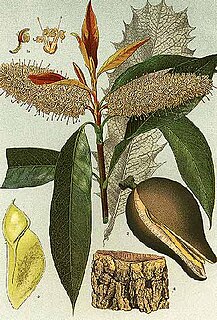
Xylomelum is a genus of six species of flowering plants, often commonly known as woody pears, in the family Proteaceae and are endemic to Australia. Plants in this genus are tall shrubs or small trees with leaves arranged in opposite pairs, relatively small flowers arranged in spike-like groups, and the fruit a woody, more or less pear-shaped follicle.

In botany, a rosette is a circular arrangement of leaves or of structures resembling leaves.
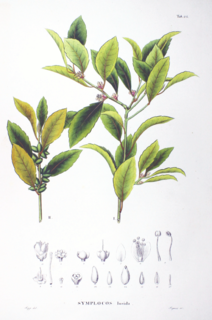
Symplocos is a genus of flowering plants in the order Ericales. It contains about 300 species distributed in Asia and the Americas. Many species grow in humid tropical regions. This is sometimes considered to be the only genus in family Symplocaceae. Plants in this family are shrubs and trees with white or yellow flowers.

The Antillean fruit-eating bat is one of two leaf-nosed bat species belonging to the genus Brachyphylla. The species occurs in the Caribbean from Puerto Rico to St. Vincent and Barbados. Fossil specimens have also been recorded from New Providence, Bahamas.
Bactris jamaicana is a spiny palm which grows in multi-stemmed clumps. It is endemic to Jamaica.

Meriania is a genus of flowering plants in the family Melastomataceae. There are about 93 species distributed from Mexico to Brazil and the Antilles.
Coccothrinax jamaicensis, the silver thatch or Jamaican silver thatch, is a fan palm believed to be endemic to Jamaica. A slender palm growing up to 8 metres (26 ft) tall, it grows in coastal areas on limestone or sand.
Philcoxia is a genus of seven rare plant species in the Plantaginaceae that are endemic to Brazil and resemble terrestrial species of the genus Utricularia. The genus, formally described in 2000, consists of the species P. bahiensis, P. goiasensis, P. minensis, P. tuberosa, P. rhizomatosa, P. maranhensis and P. courensis, each of the first three named for the Brazilian state to which it is endemic. The species are characterized by subterranean stems, peltate leaves at or below the soil surface, and five-lobed calyces. Their habitat has been reported as areas of white sand in the midst of cerrado vegetation at an elevation between 800 and 1450 m. Initial descriptions of the genus included suspicions that the plethora of stalked capitate glands on the upper surfaces of leaves was an indication that these species may be carnivorous. A study published in 2007 tested P. minensis for protease activity, a typical test for the carnivorous syndrome, and could detect none. Later studies detected other digestive enzymes such as phosphatases and qualitatively assessed prey digestion and nutrient uptake, suggesting that it is a true carnivorous plant. The genus epithet honors David Philcox, a botanist at Kew Gardens who worked extensively in tropical Scrophulariaceae.

Symplocaceae is a family of flowering plants in the order Ericales, including two genera, Symplocos and Cordyloblaste, totalling about 260 known species. The common name for Symplocaceae is sweetleaf. Symplocaceae has a transpacific distribution that covers the Southeast United States, South America, Southeast Asia and Northern Australia. Plants in the family Symplocaceae are generally trees or shrubs, and are found in humid, tropical, montane forests within their range.
Roystonea princeps, commonly known as Morass cabbage palm or Morass royal palm, is a species of palm which is endemic to western Jamaica.

Diplazium is a genus of ferns that specifically includes the approximately 400 known species of twinsorus ferns. The Greek root is diplazein meaning double: the indusia in this genus lie on both sides of the vein. These ferns were earlier considered part of either the Athyriaceae, Dryopteridaceae, Aspleniaceae, or Polypodiaceae families or recognized as belonging to their own taxonomic family. The Pteridophyte Phylogeny Group classification of 2016 places the genus in the Athyriaceae. The taxonomy of the genus is difficult and poorly known, and by 2009 has never been the subject of a complete monographic study. Their distribution is pantropical, with a few species extending into temperate areas.

Thelymitra ixioides, known as the spotted sun orchid or dotted sun orchid, is a species of orchid that is native to southern and eastern Australia and to New Zealand. It has a single long, thin, dark green leaf and up to ten flowers which occur in a range of colours, most commonly blue to purple but usually with small, dark blue spots. It is a variable species, similar to T. juncifolia which has smaller flowers.

Argyrochosma nivea is an Andean fern species in the genus Argyrochosma.
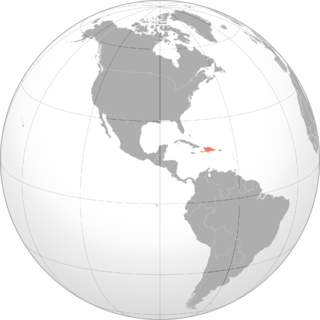
The Hispaniolan greater funnel-eared bat is a species of funnel-eared bat found on the island of Hispaniola .. First described in 1902, it has a complex taxonomic history, with some authors identifying multiple subspecies, now recognised as the separate species Natalus primus and Natalus jamaicensis, and others considering Natalus major to be itself a subspecies of Natalus stramineus. It lives primarily in caves and feeds on insects.
The Jamaican greater funnel-eared bat is a species of funnel-eared bat found in Jamaica. It was first described as Natalus major jamaicensis, later as a subspecies of Natalus stramineus, and now as its own species. It is of a similar appearance to many species of the genus Natalus. It lives solely in St. Clair Cave in Jamaica and feeds on insects.

Portlandia coccinea is a small tree or shrub with bright red flowers endemic to Jamaica. The species was first described in 1788. A population with darker flowers had been considered a subspecies of P. coccinea, but was described as a separate species, P. proctori, in 2003.
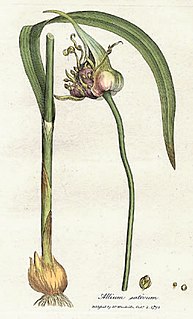
Allium is a genus of monocotyledonous flowering plants that includes hundreds of species, including the cultivated onion, garlic, scallion, shallot, leek, and chives. The generic name Allium is the Latin word for garlic, and the type species for the genus is Allium sativum which means "cultivated garlic".
Artibeus schwartzi is a species of bat found in the Lesser Antilles. It was previously considered a subspecies of the Jamaican fruit bat,. It has been hypothesized that it arose from hybridization of three Artibeus species: A. jamaicensis, A. planirostris, and an unknown third species.
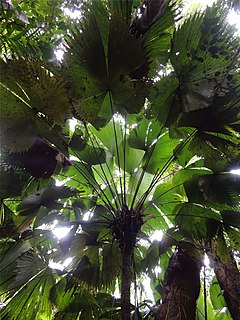
Sabinaria magnifica is a species of palm tree and the only member of the genus Sabinaria. Native to the Darién Gap on the border between Colombia and Panama, it grows from 1 to 6 metres tall with large, deeply-divided leaf blades. It has been described as "striking", "spectacular" and "beautiful" by taxonomists.












